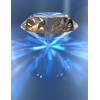|
 Diamond is
one of the most glorious and fanciest precious stones in the world and it is
not that easy to choose the right one among the variety of available. And knowing
that we ought to know a set of nuances and be able to sort out the stones, if
any. Diamond is
one of the most glorious and fanciest precious stones in the world and it is
not that easy to choose the right one among the variety of available. And knowing
that we ought to know a set of nuances and be able to sort out the stones, if
any.
If you are
proposed to have a look at two delightful stones with the bigger one to cost
cheaper, pay attention to its purity, first. Purity is commonly specified in
the passport to the stone and it seems that it is not difficult to identify with
shown figures. Though, what is the purity of the stone and why is it important?
The diamond
has the property to shine, and even the tiniest but pure diamond stone will
shine if a beam of light falls to it shocking people with its cold beauty.
While the bigger stone you want to impress the others will sparkle less, should
it has inner defects. And we need the diamonds to admire the preciousness of
stones and appear beautiful trimmed by the splendor of diamonds, don't we?
Well, let's
come back to figures that certify or disprove the purity of diamonds. We have
to warn that a rare stone comes without tiny inclusions and defects. Actually all
diamonds have inclusions of non-crystallized carbon or fine allogenic crystals
that are hardly visible after the stone is faceted for non-professional
experts. If you see visible defects on the stone in the light, then you have
the low class of the stone.
Under the international
system of diamond purity estimation at the GIA, the defects visible without
magnifying glass are seen with stones of «Small Inclusions» purity group
specified as SI1 and SI2 in the passport of the stone. If you are able to
observe foreign inclusions in stones of class SI1 at magnification, then SI2
class stones will show them without any magnifying glass. And this is not the lowest
class of stones! With «Imperfect» class stones classified as I1, I2 and I3, you
may not see visible defects without magnification, though the stones will
sparkle and shine lesser. And the lowest class of stones by the GIA classification
includes stones not only with the defects of various sizes, but the purity also
matters that makes affect to the shine, beauty and strength of the stone.
The highest
purified class of diamonds includes stones that refer to «Internally Flawless»
(IF) group. The inclusions with these stones are seen only at 10-fold
magnification. When 10-fold magnification does not reveal inner defects though
there are visible damages to the stone removable with the consequent polishing,
the diamond refers to the high class of purity.
«Very, Very
Small Inclusions» group supposes fine inclusions that are revealed as small
dots at the 10-fold magnification. And frequently VVS1 class diamonds are those
with insignificant and superficial defects removed with extra polishing.
Whereas VVS2 class diamonds are the stones with rather solid but still fine
inclusions. Small and insignificant inclusions coming as feather or clouds are
seen at the 10-fold magnification with the glass or microscope with «Very Small
Inclusions» group stones. And again, these inclusions are hardly seen with VS1
group diamonds and the defects are more visible with diamonds marked as «VS2»
group.
Hence, considering
even the purest diamond, these precious stones fall under the categories
specified as IF, VVS1, VVS2, VS1, VS2, SI1, SI2, I1, I2, I3. However, in Russia the diamonds
come with the different level of purity. This is because there is an individual
Russian system of diamond purity specification that includes the weight of the
stone also (up to 0,29 carats and higher). The conformance to the system is as follows.
The diamonds up to 0,29 carats, specified as 1,2,3 under the Russian
classification system and diamonds over 0,30 carts specified as 1,2,3,4 conform
to the groups of GIA classification IF, VVS1 and VVS2. VS1 means the 4th
group of purity for the diamonds weighing up to 0,29 carats and the 5th
group for larger stones. VS2 conforms with the diamonds of the 6th
group, SI1 to the 7th and SI2 to the 8th group with the
weight of crystals over 0.30 carats. Smaller stones of the 5th group
by the Russian classification may be classified as VS2, SI1 or SI2 by the world
standards. Less purified stones have more thorough classification by the
Russian system. If you hesitate to cope with the different values of these
systems, you are always welcome to seek the advice from the jeweler.
|